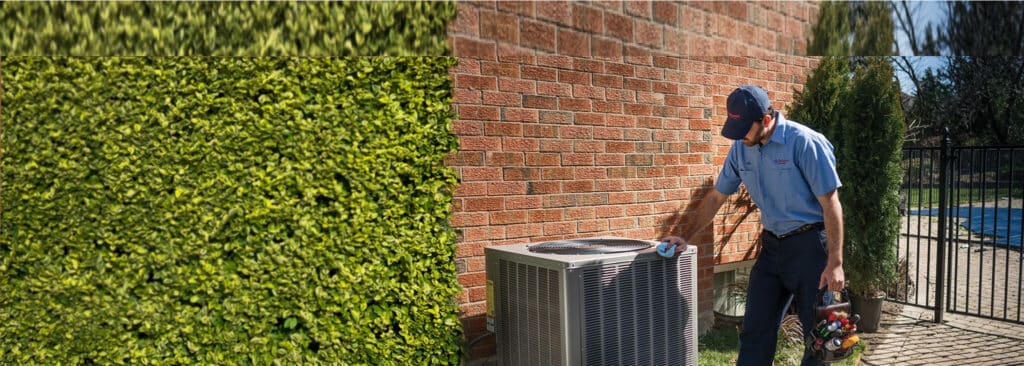We know you’re counting down the days until the warmer weather hits, and it will arrive sooner than you think! But don’t forget about your AC system, your best friend that’s going to get you through those hot summer days.
Take these simple steps to prepare your air conditioner before first use—and you’ll be more likely to stay calm, cool and collected come the next big heatwave.

1. Remove Any Blockages
Much like us, air conditioners need to have room to breathe while functioning in the warmer seasons. Before turning anything on, make sure there is nothing blocking the unit and its surroundings. You want to have at least 12 inches of space between any potential blockages like bushes, landscaping elements, fallen leaves, debris, or any other gardening.
2. Remove the Winter Cover
It sounds simple, but make sure you take that winter cover off before turning the unit on again. It can compromise the unit if it is turned on while still covered.
3. Hose Clean the Unit
Central air conditioning systems are made up of several components that, together, cool your home. These include the outside unit, whose coils, fans and other moving parts help remove heat from inside your dwelling. But dirt and debris can clog up these inner workings, making them run less efficiently.
To do: First, shut off the main power to the air conditioner (either through an outdoor on/off switch or via your electrical box located inside your home). Then, using a garden hose on a low-pressure setting, rinse the metal housing and coils of your air conditioning unit, spraying in the opposite direction of airflow. (Why “low-pressure”? Because high-pressure spray can bend the machine’s coils—one of the critical components that cool your home.)
4. Check for Wear and Tear
You may need an AC repair before trying to run your unit. One of the reasons we recommend annual maintenance for your outdoor air conditioning units is that mother nature can wear away on the different components over time. Yearly maintenance will help catch any wear and tear earlier to potentially avoid any issues in the future.
5. Replace Your Filter
The change in season is usually a good reminder to change your air conditioning filter. Replacing a dirty, clogged filter could help keep your furnace running at peak efficiency and lower your energy consumption.
Filters also help remove dust and allergens from your home, contributing to improved air quality for you and your family. If a filter looks dirty as you pull it out, it needs to be replaced or cleaned.
Visit our Indoor Air Quality Solutions to learn more.
6. Update Your Thermostat Setting
Your thermostat is a vital part of your cooling system, but when temperatures start to rise, it’s time to consider switching off the heating and turning on the cooling.
To do: Though preferences differ based on region, outside temperature and a slew of other factors, you may want to readjust your thermostat over time, first setting it to the desired temperature. Then, once you’re acclimated to the warmer weather, increase the temperature in your home until you hit an acceptable temperature for the summer ahead.
Hot tip: Upgrading to a smart thermostat allows you to take control of the temperature in your home from anywhere at any time and could help you to save money and energy by reducing system use when you’re not at home or during sleeping hours.
7. Get an Annual Maintenance Check
Just like any machine, your home’s cooling system will run most efficiently and effectively when it’s clean and set up correctly. And while you can do some upkeep, there’s simply no substitute for an experienced, licensed HVAC technician when it comes time to inspect, clean the pipes, and maintain your AC.
Manufacturers recommend yearly tune-ups to help prevent future problems and keep your cooling system operating at an optimal level. And having an experienced professional run your system through its paces could even help you to save money on your energy bills!
8. Turn the Power On at the Disconnect Box
Many homeowners turn off the disconnect for the outdoor unit during the winter. About 24 hours before powering up your AC system, make sure the disconnect box is set to “on”.
And there you have it! You’re ready to stay cool, calm and comfortable when the temperatures rise in your region.
Want to learn more about the different kinds of AC options there are available on the market today? Be sure to check out our Ultimate Air Conditioning Guide!








